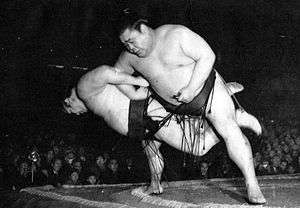Mitsuneyama Hokoku
| Mitsuneyama Hōkoku | |
|---|---|
| 三根山 宝國 | |
|
With the Emperor's Cup in 1954 | |
| Personal information | |
| Born |
Tōichi Shimamura February 7, 1922 Tokyo, Japan |
| Died | August 15, 1989 (aged 67) |
| Height | 1.76 m (5 ft 9 1⁄2 in) |
| Weight | 150 kg (330 lb) |
| Career | |
| Stable | Takashima |
| Record | 479-389-35 |
| Debut | May 1937 |
| Highest rank | Ōzeki (September 1953) |
| Retired | January 1960 |
| Championships |
1 (Makuuchi) 1 (Jūryō) 1 (Sandanme) |
| Special Prizes |
Outstanding Performance (5) Fighting Spirit (2) |
| Gold Stars |
9 Terukuni (3) Kagamisato (2) Akinoumi Maedayama Azumafuji Chiyonoyama |
| * Up to date as of December 2009. | |
Mitsuneyama Hokoku, real name Toichi Shimamura (7 February 1922 – 15 August 1989) was a sumo wrestler from Arakawa, Tokyo, Japan.
Career

He began his professional career in 1937, joining Takashima stable, reaching the top makuuchi division in 1944. He earned nine kinboshi or gold stars for defeating yokozuna whilst ranked as a maegashira, and seven sanshō or special prizes. In 1953, at the age of 31, he was promoted to the second highest rank of ōzeki, and three tournaments later took his only top division yūshō or tournament championship, with a 12-3 record. He lost the ōzeki rank in 1955, largely due to injuries. He carried on fighting in the maegashira ranks until January 1960 when he retired at the age of nearly 38.
Retirement from sumo
He remained in the sumo world as a toshiyori or elder of the Japan Sumo Association, and became the head coach of the Takashima stable in May 1961. He produced the top division wrestlers Daiju and Koboyama, but resigned due to ill health in 1982, the heya being absorbed into Kumagatani stable.[1] He continued to work as a coach at Kumagatani before leaving the Sumo Association in January 1985. He died in 1989.
Pre-modern top division record
- Through most of the 1940s only two tournaments were held a year and only one tournament was held in 1946. The New Year tournament began and the Spring tournament returned to Osaka tournament in 1953.
| - | Spring Haru basho, Tokyo |
Summer Natsu basho, Tokyo |
Autumn Aki basho, Tokyo |
|---|---|---|---|
| 1944 | West Maegashira #12
11–4 |
East Maegashira #4
7–3 ★★ |
East Maegashira #1
6–4 ★ |
| 1945 | Not held | West Komusubi #1
1–6 |
West Maegashira #6
3–7 |
| 1946 | Not held | Not held | West Maegashira #10
11–2 |
| 1947 | Not held | East Komusubi #2
4–5–1 |
East Maegashira #2
8–3 ★ |
| 1948 | Not held | West Komusubi #1
7–4 |
East Sekiwake #1
4–7 |
| 1949 | East Maegashira #2
9–4 O★ |
West Komusubi #1
6–8–1 |
West Maegashira #1
8–7 |
| 1950 | West Sekiwake #1
3–6–6 |
East Maegashira #2
8–7 ★ |
East Komusubi #1
11–4 |
| 1951 | East Sekiwake #2
13–2 O |
East Sekiwake #1
7–8 |
East Sekiwake #2
11–4 O |
| 1952 | East Sekiwake #1
8–7 |
West Sekiwake #1
11–4 O |
East Sekiwake #1
6–9 |
| - | New Year Hatsu basho, Tokyo |
Spring Haru basho, Osaka |
Summer Natsu basho, Tokyo |
Autumn Aki basho, Tokyo | ||
|---|---|---|---|---|---|---|
| 1953 | East Komusubi #2
10–5 |
East Sekiwake #2
11–4 F |
East Sekiwake #1
12–3 O |
East Ōzeki #2
8–7 |
||
| 1954 | East Ōzeki #2
10–5 |
East Ōzeki #1
12–3 |
East Ōzeki #1
10–5 |
West Ōzeki #1
5–10 |
||
| 1955 | East Ōzeki #1
9–6 |
East Ōzeki #1
3–7–5 |
West Ōzeki #1
6–9 |
East Sekiwake #2
Sat out due to injury 0–0–15 |
||
| 1956 | East Maegashira #2
4–11 |
West Maegashira #6
5–10 |
East Maegashira #13
9–6 |
West Maegashira #10
10–5 F |
||
| Record given as win-loss-absent Top Division Champion Retired Lower Divisions Sanshō key: F=Fighting spirit; O=Outstanding performance; T=Technique Also shown: ★=Kinboshi(s); P=Playoff(s) | ||||||
Modern tournament record
- Since the addition of the Kyushu tournament in 1957 and the Nagoya tournament in 1958, the yearly schedule has remained unchanged.
| Year in sumo | January Hatsu basho, Tokyo |
March Haru basho, Osaka |
May Natsu basho, Tokyo |
July Nagoya basho, Nagoya |
September Aki basho, Tokyo |
November Kyūshū basho, Fukuoka |
|---|---|---|---|---|---|---|
| 1957 | East Maegashira #2
7–8 ★ |
East Maegashira #3
5–10 |
East Maegashira #6
9–6 ★ |
Not held | East Maegashira #2
6–9 ★ |
West Maegashira #3
5–10 |
| 1958 | East Maegashira #8
5–10 |
East Maegashira #14
10–5 |
West Maegashira #7
10–5 |
East Maegashira #2
7–8 |
West Maegashira #3
6–9 |
East Maegashira #5
7–8 |
| 1959 | East Maegashira #6
6–9 |
East Maegashira #8
7–8 |
West Maegashira #9
7–8 |
West Maegashira #10
8–7 |
East Maegashira #9
9–6 |
East Maegashira #3
2–13 |
| 1960 | East Maegashira #13
Retired 4–4–7 |
|||||
| Record given as win-loss-absent Top Division Champion Retired Lower Divisions Sanshō key: F=Fighting spirit; O=Outstanding performance; T=Technique Also shown: ★=Kinboshi(s); P=Playoff(s) | ||||||
See also
- List of sumo record holders
- List of sumo tournament top division champions
- List of sumo tournament second division champions
- List of past sumo wrestlers
- List of ōzeki
References
- ↑ Sharnoff, Lora (1993). Grand Sumo. Weatherhill. p. 205. ISBN 0-8348-0283-X.
- ↑ "Mitsuneyama Hokoku Rikishi Information". Sumo Reference. Retrieved 2013-05-23.